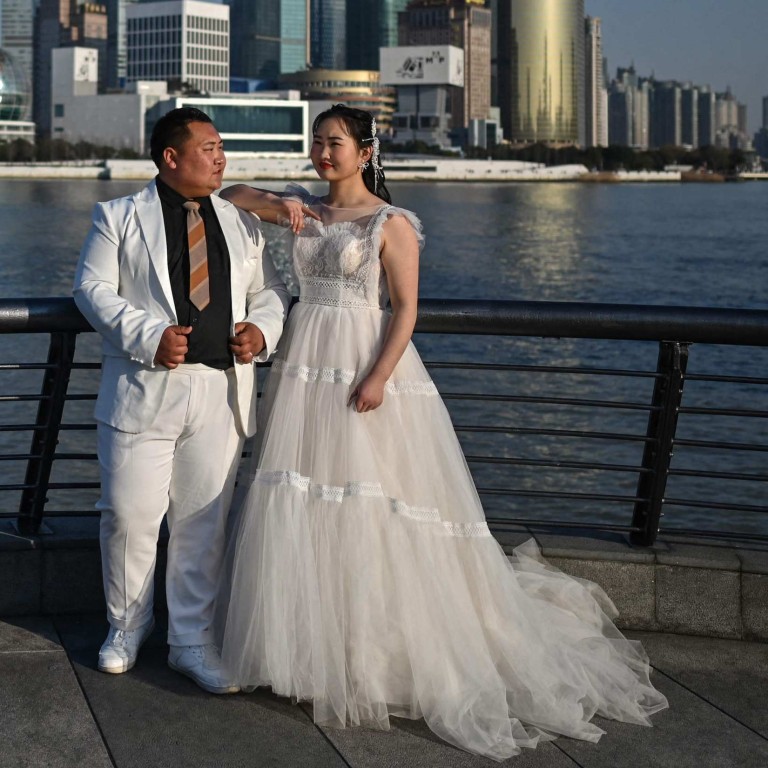
Marriage on the rocks in China as women rethink their options and Covid-19 limits take toll
- In 2021, the lowest number of couples tied the knot since records began in 1986
- A range of factors at play, from coronavirus restrictions to the legacy of the one-child policy, observers say
The number of marriages in China hit a new low last year, extending a near decade-long decline and casting a shadow over Beijing’s efforts to raise the fertility rate.
The Ministry of Civil Affairs said on Friday that around 7.63 million marriages were registered in 2021, the lowest total since 1986 when records began.
That compared with more than 8.13 million in 2020 and a peak of 13.46 million marriages in 2013.
According to independent analysis, the number of marriages per 1,000 people in China was 5.41 last year compared with 9.88 in 2013.
Marriage rates were lowest in Shanghai and Zhejiang, Fujian, Hebei, and Hunan provinces, and highest in Tibet, Qinghai, Guizhou, Anhui, and Ningxia, the ministry said.
Researchers said long-term and short-range factors were at play.
Independent demographer He Yafu said young Chinese women were changing their view of marriage and parenting.
“As their education and economic independence levels increase, the percentage of women who are single is increasing,” He said.
“They don’t need to be dependent on a husband or married to live well.”
Among adults aged 20 to 34, women accounted for 52.7 per cent of those with at least a bachelor’s degree, according to central government data for 2021.
And in a Communist Youth League survey of unmarried urban residents aged 18 to 26 in October, 43.9 per cent of women respondents said they either had no intention of getting married or were unsure if it would happen. That was 19.3 percentage points higher than the unmarried male respondents.
Are young Chinese falling out of love with marriage?
He said imbalances in the country’s gender ratio were also contributing to the decline in marriages.
Since the introduction of the one-child policy in the 1980s, birth rates for males have been higher than for females.
For example, among about the 220 million Gen Z population – roughly those born between 1995 and 2010 – there are 18.27 million more men than women, according to the youth league.
The one-child policy was eased to two children in 2015 and three last year.
Yi Fuxian, a researcher at the University of Wisconsin-Madison and a long-standing critic of China’s birth restrictions, said coronavirus pandemic restrictions had also contributed to fewer marriages.
Yi said that if not for the pandemic there would have been 7.97 million marriages last year, or 340,000 more than were registered.
In 2020, there would have been 8.64 million marriages, or 510,000 more than were recorded, he said.
“Combined with the fact that many people have given up on having children, the epidemic will result in millions of fewer new births,” Yi said.
China’s three-child policy will not ‘drastically raise birth rate’
The number of births is also on the decline, with the total falling for the fifth consecutive year to 10.62 million babies in 2021, or 11.5 per cent lower than a year earlier, according to the National Bureau of Statistics.
The YuWa Population Research think tank, which advocates for lifting birth restrictions, said China had one of the lowest fertility rates in the world.
It said the rate dropped from 1.77 children per woman of childbearing age in 2016 to 1.15 last year. A rate below 1.5 usually means a population decline.
Yi projected that there would be fewer than 10 million births this year and China was entering a period of negative population growth, nine years earlier than forecasts by the State Council’s national population development plan.
“If a woman gets pregnant, she has to go to the hospital for the monthly maternity check-ups, which are cumbersome and risky under the current severe zero-Covid strategy. So many people have given up their pregnancy plans in the past two years,” he said.
“If China continues its current anti-epidemic policy, there will be another birth plunge in 2023.”
“[Authorities could] guarantee the rights of single women to freeze their eggs and have test tube babies through in vitro fertilisation, and let social insurance cover the costs,” He said.


